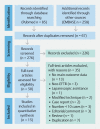Efficacy and safety of gastric exposed endoscopic full-thickness resection without laparoscopic assistance: a systematic review
- PMID: 32904958
- PMCID: PMC7458762
- DOI: 10.1055/a-1198-4357
Efficacy and safety of gastric exposed endoscopic full-thickness resection without laparoscopic assistance: a systematic review
Erratum in
-
Erratum: Efficacy and safety of gastric exposed endoscopic full-thickness resection without laparoscopic assistance: a systematic review.Endosc Int Open. 2020 Sep;8(9):C4. doi: 10.1055/a-1527-7164. Epub 2021 Jun 16. Endosc Int Open. 2020. PMID: 34150984 Free PMC article.
Abstract
Background and study aims Exposed endoscopic full-thickness resection (Eo-EFTR) without laparoscopic assistance is a minimally invasive natural orifice transluminal endoscopic surgery (NOTES) technique that has shown promising efficacy and safety in resection of gastric submucosal tumors (G-SMTs) arising from muscularis propria (MP). However, data on the efficacy and safety of gastric Eo-EFTR mostly come from relatively small retrospective studies and concern regarding its use still exists. The aim of our systematic review was to assess the efficacy and safety of gastric Eo-EFTR without laparoscopic assistance. Methods A detailed MEDLINE and EMBASE search was performed for papers published from January 1998 to November 2019 and reporting on gastric Eo-EFTR without laparoscopic assistance. The search strategy used the terms "endoscopic full thickness resection" and "gastric" or "stomach". The primary outcomes were complete resection and surgical conversion rates. The secondary outcomes were overall major adverse events, delayed bleeding, delayed perforation, peritonitis, abdominal abscess and/or abdominal infection and successful Eo-EFTR. Results Fifteen Asian studies were included in our final review, providing data on 750 Eo-EFTR-treated G-SMTs. The per-lesion rate of complete resection and surgical conversion were 98.8 %\0.8 %, respectively. The per-lesion rate of major adverse events, delayed bleeding, delayed perforation and peritonitis, abdominal abscess and/or abdominal infection was 1.6 %\0.5 %\0.1 %\0.9 %, respectively. The per-lesion rate of successful Eo-EFTR (i. e. complete tumor resection and effective endoscopic defect closure) was 98.3 %. Conclusions Eo-EFTR without laparoscopic assistance appears to be highly effective and safe NOTES for removing deep G-SMTs, particularly those arising from MP layer.
Conflict of interest statement
Competing interests The authors declare that they have no conflict of interest.
Figures
References
-
- von Mehren M, Randall R L, Benjamin R S et al.Soft Tissue Sarcoma, Version 2. 2018, NCCN Clinical Practice Guidelines in Oncology. J Natl Compr Canc Netw. 2018;16:536–563. - PubMed
-
- Cai M, Zhou P, Lourenço L C et al.Endoscopic full-thickness resection (EFTR) for gastrointestinal subepithelial tumors. Gastrointest Endosc Clin N Am. 2016;26:283–295. - PubMed
-
- Cai M Y, Martin Carreras-Presas F, Zhou P H. Endoscopic full-thickness resection for gastrointestinal submucosal tumors. Dig Endosc. 2018;30:17–24. - PubMed
-
- Mori H, Kobara H, Nishiyama N et al.Current status and future perspectives of endoscopic full-thickness resection. Dig Endosc. 2018;30:25–31. - PubMed
Publication types
LinkOut - more resources
Full Text Sources


